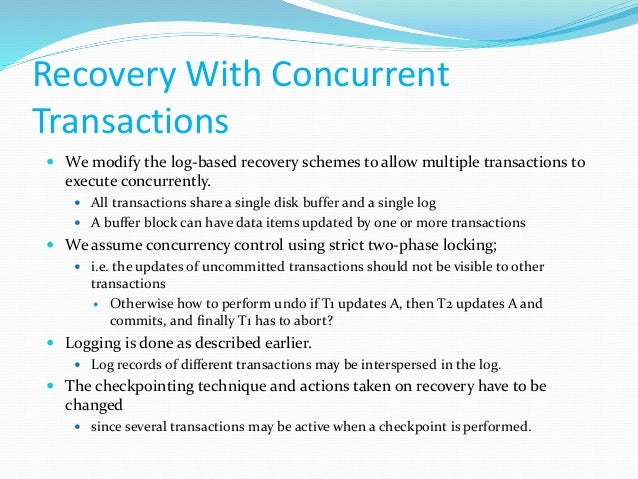Log Based Recovery In Dbms Pdf
- DBMS Tutorial
Assess Recovery Requirements First Step in Data Protection Planning •Identify and prioritize critical data •Design recovery requirements around data criticality –Assess tolerance for data loss - Recovery Point Objective (RPO) •How frequently should backups be taken? •Point-in-time recovery required? Below we show the log as it appears at three instances of time. Recovery actions in each case above are: (a) undo (T0): B is restored to 2000 and A to 1000, and log records,, are written out (b) redo (T0) and undo (T1): A and B are set to 950 and 2050 and C is restored to 700. Recovery system in dbms ppt affects all. Recovery algorithms are techniques to ensure database consistency. Log based recovery system in dbms System errors: the database system must terminate an active. Backup and recovery system in dbms Recovery algorithms are techniques to ensure database.Chapter 11. Recovery system in dbms rcr311s manual pdf pdf Two common kinds of failures.
- Entity Relationship Model
- Relational Model
- Relational Database Design
- Storage and File Structure
- Indexing and Hashing
- Transaction And Concurrency
- Backup and Recovery
- DBMS Useful Resources
- Selected Reading
In a multiprogramming environment where multiple transactions can be executed simultaneously, it is highly important to control the concurrency of transactions. We have concurrency control protocols to ensure atomicity, isolation, and serializability of concurrent transactions. Concurrency control protocols can be broadly divided into two categories −
- Lock based protocols
- Time stamp based protocols
Lock-based Protocols
Database systems equipped with lock-based protocols use a mechanism by which any transaction cannot read or write data until it acquires an appropriate lock on it. Locks are of two kinds −
Binary Locks − A lock on a data item can be in two states; it is either locked or unlocked.
Shared/exclusive − This type of locking mechanism differentiates the locks based on their uses. If a lock is acquired on a data item to perform a write operation, it is an exclusive lock. Allowing more than one transaction to write on the same data item would lead the database into an inconsistent state. Read locks are shared because no data value is being changed.
There are four types of lock protocols available −

Simplistic Lock Protocol

Simplistic lock-based protocols allow transactions to obtain a lock on every object before a 'write' operation is performed. Transactions may unlock the data item after completing the ‘write’ operation.
Pre-claiming Lock Protocol
Pre-claiming protocols evaluate their operations and create a list of data items on which they need locks. Before initiating an execution, the transaction requests the system for all the locks it needs beforehand. If all the locks are granted, the transaction executes and releases all the locks when all its operations are over. If all the locks are not granted, the transaction rolls back and waits until all the locks are granted.
Two-Phase Locking 2PL
This locking protocol divides the execution phase of a transaction into three parts. In the first part, when the transaction starts executing, it seeks permission for the locks it requires. The second part is where the transaction acquires all the locks. As soon as the transaction releases its first lock, the third phase starts. In this phase, the transaction cannot demand any new locks; it only releases the acquired locks.
Two-phase locking has two phases, one is growing, where all the locks are being acquired by the transaction; and the second phase is shrinking, where the locks held by the transaction are being released.
To claim an exclusive (write) lock, a transaction must first acquire a shared (read) lock and then upgrade it to an exclusive lock.
Strict Two-Phase Locking
The first phase of Strict-2PL is same as 2PL. After acquiring all the locks in the first phase, the transaction continues to execute normally. But in contrast to 2PL, Strict-2PL does not release a lock after using it. Strict-2PL holds all the locks until the commit point and releases all the locks at a time.
Strict-2PL does not have cascading abort as 2PL does.
Timestamp-based Protocols
The most commonly used concurrency protocol is the timestamp based protocol. This protocol uses either system time or logical counter as a timestamp.
Log Based Recovery In Dbms Pdf Pdf
Lock-based protocols manage the order between the conflicting pairs among transactions at the time of execution, whereas timestamp-based protocols start working as soon as a transaction is created.
Log Based Recovery In Dbms Pdf Free
Every transaction has a timestamp associated with it, and the ordering is determined by the age of the transaction. A transaction created at 0002 clock time would be older than all other transactions that come after it. For example, any transaction 'y' entering the system at 0004 is two seconds younger and the priority would be given to the older one.
Get all the power of a hardware studio inside of your computer. Review Comments Questions & Answers Update program info. Old versions. Start making beats today with Cakewalk Kinetic. Get all the power of a hardware studio inside of your computer. Halo 5's map editor is now available for free in Windows. Cakewalk kinetic 2 free download torrent.
In addition, every data item is given the latest read and write-timestamp. This lets the system know when the last ‘read and write’ operation was performed on the data item.
Timestamp Ordering Protocol
The timestamp-ordering protocol ensures serializability among transactions in their conflicting read and write operations. This is the responsibility of the protocol system that the conflicting pair of tasks should be executed according to the timestamp values of the transactions.
Dbms Notes Pdf
- The timestamp of transaction Ti is denoted as TS(Ti).
- Read time-stamp ofwrite' operation itself is ignored.